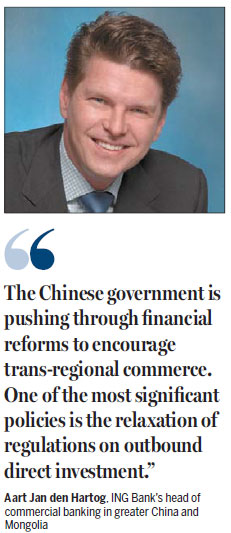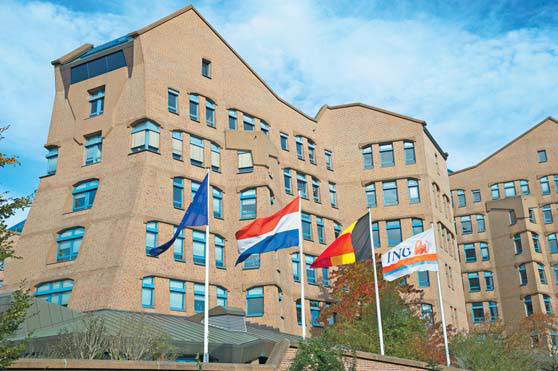Banking on the dynamics of China's 'new normal'
Aart Jan den Hartog, ING Bank's Head of Commercial Banking in Greater China and Mongolia, discusses how the bank helps clients maximize the potential of China's "new normal", and what it takes for a commercial bank to support businesses looking to expand sustainably across the globe.
Can you briefly describe ING Bank's business, especially in China?
ING is a global financial institution of Dutch origin, with a truly international network covering over 40 countries around the world. We serve more than 33 million private, corporate and institutional customers.
Our history in Asia goes back more than a century. Today, our commercial, retail and direct banking businesses span 14 markets across Asia, with mainland China being one of the markets with potential for high growth.
In the mainland, we are present in Shanghai and Beijing, serving clients throughout China. Beyond this, we are focused on partnering with our clients in Europe, the Americas and other parts of Asia to meet their business ambitions to leverage the potential of the Chinese market.
Also, for Chinese corporates who are looking to tap opportunities outside of China, ING provides access to a comprehensive network and a platform with global reach.
Who are your clients? What are they looking for from ING Bank?
In China, our clientele is highly diverse, ranging from State-owned enterprises and privately owned mainland businesses to Hong Kong blue chips and European multinationals. Our clients see us as their partner and many of our clients have been banking with us for more than 20 years.
As a European bank, we pride ourselves on our strong heritage and full-service capabilities, as well as deep understanding of the market dynamics in Europe.
In Asia, our on-the-ground presence in key Asian markets and local market insights enable us to help our clients navigate the ups and downs throughout different stages of their business.
As a Dutch-based financial institution, what added-value are you bringing to your Chinese clients?
First, we have a very clear strategy and unique positioning. In Asia, we are not everything for everyone. We partner with clients to whom we can provide added-value in areas where we are relevant.
Our clients benefit from our specialized lending expertise in sectors we are strong in and where the entry barriers are high.
For example, ING Bank is a key player in trade and commodity finance, telecommunications, media and technology, transportation, natural resources, utilities and infrastructure, among others.
Our track record in managing complex transactions and structuring products has been consistently recognized by clients, competitors and industry bodies.
We further deepen our relationships with our clients with our flow products in transaction services and financial markets.
Second, our Chinese clients value the comprehensive network that ING has in Europe, which includes locally incorporated banks in key markets such as the Benelux (Belgium, Netherlands, and Luxembourg), Spain, France, Italy, Germany, Romania, Poland and Turkey.
As the leading bank in the Benelux and Germany, we have a deep understanding of local markets to support our Chinese clients as they "go global".
Third, combining the above, we are able to provide our clients with local expertise and insights, and to generate ideas and tailored solutions.
We are able to support our clients across borders and bridge cultural differences. This results in the effective, transparent and timely execution of transactions, which allows our clients to stay one step ahead in business.
With the emergence of the "new normal" of China's economy, what are the key trends in China-Europe trade and investment activities?
While China is no longer reporting double-digit growth, the Chinese government is still committed to a relatively high rate of growth: 7 percent vis--vis the 2 percent global average.
The European Union has been China's largest trade partner for 10 consecutive years, with bilateral trade totaling $615.1 billion last year and expected to reach $1 trillion by 2020. Given the number of industries subject to foreign investment restrictions has halved, there are clear signs that the potential for trade between China and Europe is immense.
At the same time, Chinese companies are ploughing more and more money into projects abroad at a pace that is poised to surpass inbound flows.
In fact, China's outbound investment soared 14.1 percent to a record high of $102.9 billion last year, with the share to the EU nearly doubled. As China's buying spree continues, the government is expecting the outbound investment this year to reach $113 billion.
As China's economy is transitioning from an export-driven growth model to a consumption-oriented one, not only will growth become more sustainable, the demand for high-end, as well as value-added, products and services will also surge.
At the recent session of the People's National Congress (China's top legislature) much emphasis was given to research and development in innovative sectors, specialized electronics, clean energy, and food safety. This is where Europe can assume a vital role, and where cross-border investment opportunities will arise.
What makes the Netherlands attractive for international trade and business, especially when peripheral Europe remains volatile?
A number of metrics suggests the Netherlands economy is in a much stronger position than some of its peers in Europe. Unemployment is starting to come down, real wages are rising, and the housing market is also showing signs of revival.
As the sixth-largest destination for foreign direct investment in the world, and the third-largest exporter in the eurozone, the Netherlands has long been distinguished by its stability, highly skilled workforce, multiculturalism, well-developed infrastructure, technological know-how, and central location, as well as favorable investment climate.
Thanks to these, the Netherlands has become the second most popular destination for Chinese investment in the EU, while 13 percent of Chinese companies in Europe prefer to be based in the Netherlands.
As a Dutch-based global bank, we are definitely excited about the upward trend. Our role is to connect Chinese businesses with access to opportunities in the Netherlands and, for that matter, elsewhere in Europe.
How has the government helped trans-regional commerce under its financial reform?
The Chinese government has been active in pushing through financial reforms to encourage trans-regional commerce. One of the most significant policies is the relaxation of regulations on outbound direct investment. Apart from simplifying the sanction procedures for overseas investment since September, the Ministry of Commerce no longer requires every single deal to gain prior approval.
We are also seeing a strong uptick in the international real estate market since cash-rich Chinese insurers are permitted to invest up to 30 percent of their assets in property, with a maximum 15 percent offshore. According to the investment management company JLL, Europe was the most popular destination for Chinese overseas property investment in 2014, raking in a total of $5.5 billion.
Looking ahead we can expect cross-border investments to further accelerate on the back of the New Silk Road Initiative, the China (Shanghai) Pilot Free Trade Zone, and the internationalization of the renminbi.
How do you support Chinese companies going global?
As one of the leading banks specializing in China-Europe connectivity, we offer quality access to Europe for Chinese companies, helping to expand their business or market presence across the region through lending, transaction services and financial market products. We also advise on and facilitate possible merger and acquisition opportunities that tie in with their growth strategy.
|
ING Bank's headquarters in Amsterdam, the Netherlands. |

(China Daily 03/27/2015 page17)















